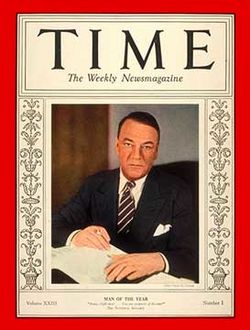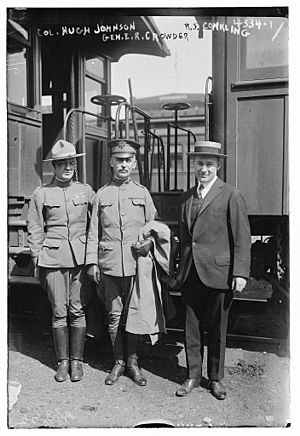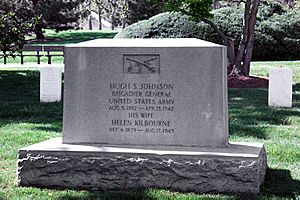Hugh S. Johnson facts for kids
Hugh Samuel Johnson (August 5, 1882 – April 15, 1942) was an important figure in American history. He was an Army officer, a businessman, and a government official. He is most famous for being part of President Franklin D. Roosevelt's "Brain Trust" from 1932 to 1934. This group of experts helped plan the New Deal, a series of programs to help the country recover from the Great Depression.
Johnson wrote many speeches for President Roosevelt and helped create the New Deal. In 1933, he was chosen to lead the National Recovery Administration (NRA). He worked very hard on the "blue eagle" campaign, which aimed to reorganize American businesses. The goal was to reduce competition and help raise wages and prices. Historians say he was a great organizer, but he also had a strong personality. The NRA program ended in 1935 after the Supreme Court ruled against it. Johnson left the administration after about a year.
Quick facts for kids
Hugh S. Johnson
|
|
|---|---|

Hugh S. Johnson on the cover of Time
|
|
| Birth name | Hugh Samuel Johnson |
| Nickname(s) | Iron Pants |
| Born | August 5, 1882 Fort Scott, Kansas, U.S. |
| Died | April 15, 1942 (aged 59) Washington, D.C., U.S. |
| Allegiance | United States |
| Service/ |
United States Army |
| Years of service | 1903–1919 |
| Rank | Brigadier general |
Contents
Early Life and Education
Hugh Samuel Johnson was born in Fort Scott, Kansas, in 1882. His parents were Samuel L. and Elizabeth Johnson. His grandparents had moved to the United States from Ireland in 1837.
Hugh's father was a lawyer. Hugh went to public school in Wichita, Kansas. Later, his family moved to Alva, Oklahoma, which was then called Oklahoma Territory. When he was 15, he wanted to join the Oklahoma state militia. His father helped him get into the United States Military Academy at West Point, a famous military school. Hugh found a way to get the spot, and he entered the Academy in 1899.
Military Career Highlights
Johnson graduated from West Point on June 11, 1903. He became a second lieutenant in the 1st Cavalry. One of his classmates at West Point was Douglas MacArthur, who later became a very famous general.
From 1907 to 1909, Johnson was stationed in the Philippines. He later moved to California. In the early 1900s, the U.S. Army managed many national parks. Johnson was stationed at Yosemite National Park and Sequoia National Park. He became a first lieutenant in 1911 and was named superintendent of Sequoia National Park in 1912.
Johnson wanted to follow his father's path in law. He got permission to study at the University of California, Berkeley. He earned his Bachelor of Arts degree in 1915 and his law degree in 1916. He then joined the Judge Advocate General's Corps (JAG), which is the legal branch of the Army.
In 1916, he served under General John J. Pershing in Mexico. He was promoted to captain in July 1916. He then moved to the JAG headquarters in Washington, D.C.. As the U.S. entered World War I in April 1917, Johnson was promoted to major in May 1917 and to lieutenant colonel in August 1917.
World War I Service
As a captain, Johnson helped write the rules for the Selective Service Act of 1917. This law created the draft, which meant that young men had to register for military service. Johnson took important steps to start the draft even before Congress officially approved it. This action could have gotten him into trouble, but Congress passed the law a month later.
He was promoted to colonel in January 1918 and to brigadier general in April 1918. At 35, he was one of the youngest people to become a brigadier general since the American Civil War. During the war, he was a strong second-in-command in the Provost Marshal's office, helping to plan and carry out the draft.
After becoming a brigadier general, Johnson became the director of the Purchase and Supply Branch of the General Staff in April 1918. He worked closely with the War Industries Board, which managed wartime production. He impressed many business leaders, including Bernard Baruch, who led the War Industries Board. These connections later helped Johnson get a job in President Roosevelt's administration.
Johnson left the U.S. Army on February 25, 1919. For his work in the Provost Marshal's office and with the draft, he received the Distinguished Service Medal (U.S. Army) in 1926.
New Deal Contributions
After leaving the Army, Johnson worked as a manager for the Moline Plow Company starting in 1919. The company's president, George Peek, and Johnson both supported a proposed law called the McNary–Haugen Farm Relief Bill. This bill would have created the first farm price supports in U.S. history, helping farmers get fair prices for their crops.
In 1927, Johnson became an adviser to Bernard Baruch. He joined Franklin D. Roosevelt's "Brain Trust" during the 1932 presidential election. His main job was writing speeches for Roosevelt. He helped draft a famous speech where Roosevelt criticized the spending of the previous administration and called for careful financial policies.
Leading the NRA
Johnson played a big role in the New Deal. In 1933, President Roosevelt chose him to lead the National Recovery Administration (NRA). The NRA aimed to organize thousands of businesses under special rules created by trade groups and industries.
Johnson was recognized for his hard work. Time magazine named him "Man of the Year" for 1933, choosing him over President Roosevelt.
By 1934, Johnson faced many challenges in his role. The NRA began to struggle, and it was eventually ended in 1935. Johnson also faced criticism for his leadership style. Because of these difficulties, President Roosevelt ended Johnson's time in the administration in September 1934.
Sarah Lucille Turner, one of the first women elected to the Missouri House of Representatives, worked with Johnson for a time while he was leading the NRA.
Later Life and Journalism
After leaving the Roosevelt administration, Hugh Johnson became a newspaper columnist. He wrote about politics for national newspapers. He supported Roosevelt in the 1936 presidential election. However, when Roosevelt proposed some changes to the Supreme Court in 1937, Johnson disagreed with him.
In 1939, Johnson supported isolationism, meaning he believed the U.S. should stay out of World War II. In the 1940 presidential election, he supported Wendell Willkie, the Republican candidate.
Johnson also wrote articles and stories. One of his stories, called The Dam, was written in 1911. It was a "future history" piece about Japan invading California.
General Hugh S. Johnson passed away in Washington, D.C., in April 1942 from pneumonia. He was buried in Arlington National Cemetery.
Awards
- Distinguished Service Medal (U.S. Army)
- Philippine Campaign Medal
- Mexican Service Medal
- World War I Victory Medal (United States)
Dates of Rank
| No insignia | Cadet, United States Military Academy: June 13, 1899 |
| No insignia in 1903 | Second Lieutenant, Regular Army: June 11, 1903 |
| First Lieutenant, Regular Army: March 11, 1911 | |
| Captain, Regular Army: July 1, 1916 | |
| Major, Regular Army: May 15, 1917 | |
| Lieutenant Colonel, National Army: August 5, 1917 | |
| Colonel, National Army: January 8, 1918 | |
| Brigadier General, National Army: April 15, 1918 |
See also
 In Spanish: Hugh Samuel Johnson para niños
In Spanish: Hugh Samuel Johnson para niños




